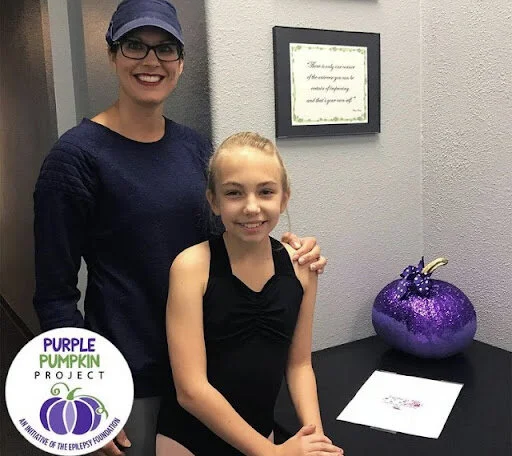Spreading Epilepsy Awareness in the Studio
By Emma Spencer, DWC Ambassador
Click below to shop the look:
If you are a friend of mine or have even been following me on social media, you'll know that epilepsy is a topic I care very passionately about. It's something that has affected my family for a little over seven years now. More specifically, my sibling, Hanna was diagnosed with epilepsy when they were seven years old, and I like to think that I’m well educated on the topic. I'm a major advocate for spreading awareness about different types of seizures and seizure first aid and debunking misinformation. I find great importance in educating others on seizures and epilepsy.
Epilepsy is one of the most common neurological disorders in the world. It affects all ages and a seizure can happen to anyone at any time. Some seizures are triggered by certain actions, stress, strobing lights, dehydration, hitting your head, and even certain sounds. Some seizures don’t have a specific trigger, such as Hanna’s seizures. An estimated five million people around the world are diagnosed with epilepsy each year according to the World Health Organization. Epilepsy is not contagious in any way. You cannot swallow or choke on your tongue if you’re having a seizure. It’s also important to note that having a seizure does not necessarily mean that you have epilepsy. Your seizure may have been situational or caused by another underlying medical condition. There are different types of seizures and not all of them involve falling to the ground and violently contracting. Hanna, for example, has partial focal seizures in their left temporal lobe. They are completely lucid and can go about their day normally while having a seizure. They actually did a whole petit allegro combination while having a seizure one time!
Something I appreciate that my studio has done is provide our dance instructors with seizure first aid instructions in the back of our attendance books, as well as require any newly registered dancers to list if they have any seizure disorders upon registration. After a former dance instructor at my studio was diagnosed with epilepsy about a year ago, she had a conversation with my competition group on what to do if she had a seizure, since hers were “grand mal seizures” (a type of seizure that includes a loss of consciousness and violent muscle contractions. They are also known as tonic-clonic seizures). She even had Hanna share some of their experiences with epilepsy. Myself and our office manager are even certified to perform seizure first aid!
I’m so grateful that I attend a studio where staff members educate themselves based on the needs of their dancers. However, we have to raise awareness that seizures can happen to anyone at any time, and that training staff on epilepsy first aid only when you know you have a student or teacher with epilepsy can be very dangerous. Last year in November, I was doing a combination in my contemporary class, and I hit my head really hard on the floor when transitioning to the ground. I ended up with a concussion, but if I had hit my head just right, I could have had a seizure. I do not have a history of seizures. My point is, some seizures are situational. There could be an incident where a student hits their head in the right spot while doing a combination, or someone could have their first seizure during class. If you don’t have the proper training or education on seizures, you might not know what to do, and that could lead to some very dangerous consequences.
Studio owners, please take the time to have a conversation with your staff and students about epilepsy and seizure first aid. I’m including students in the mix because they will need to know what to do if a teacher has a seizure or if a fellow student has a seizure and a teacher is not present. Having epilepsy first aid sheets or posters hung up in your studio can spread awareness to parents as well! It would even be a good idea to have your staff complete CPR training as well. The safety of your staff and students is incredibly important.
On the topic of seizure first aid, I would like to go over some information on performing first aid on someone who is having a seizure:
Despite how scary a seizure can be, they actually only need emergency medical attention under certain circumstances, such as:
The person has never had a seizure before
They have difficulty breathing or walking after a seizure
The seizure lasts more than 5 minutes
The person hits their head or is overall injured
The seizure happens in water
The person is pregnant, had diabetes, heart disease, or another health condition
The person has another seizure soon after the first one
There are many different types of seizures: Absent, Focal Aware, and Grand Mal are the most commonly identified. The steps you’ll want to take for general seizure first aid are as follows:
Stay with the person until the seizure ends and when they completely regain consciousness.
Direct them to a safe area, or move any objects that may cause harm to the person out of the way if they’re having a grand mal seizure
After regaining consciousness, communicate calmly to the person what happened and comfort them
Grand Mal/Tonic-Clonic Seizure First Aid
Grand Mal or Tonic-Clonic Seizures come with a slightly different and more detailed protocol since there are a lot of parts to a grand mal. Here are the steps you should follow:
If you can, ease the person gently to the ground
Move the person to their side. This position actually allows the person having a seizure to breathe much easier!
Make sure any hard or sharp objects are out of the way
Check for a medical ID or bracelet and time the seizure. !f it lasts longer than 5 minutes, call 911
Do not stick any objects or your fingers in their mouth, do not give any water, pills, or food until the person is completely conscious and the seizure is over
Do not hold the person down or restrain them
Put something soft and flat under their head (a folded jacket or blanket will work)
Remove their glasses if they are wearing any
Make sure clothing is loosened around the neck and remove any ties or necklaces if they are present
Stay with the person until the seizure is over and they regain consciousness
For more information on seizures and what you can do to spread awareness, I have listed multiple sources I used to write this blog and even a couple of articles on dancers who have epilepsy and their experiences. I highly recommend checking out these sources, as they contain multitudes of information that I didn’t even graze upon in this blog post that is super important to know. I also recommend browsing around the Epilepsy Foundation’s website. The majority of their staff and volunteers have epilepsy themselves and the website contains a plethora of useful and fascinating information. You can also become seizure first aid certified after taking a webinar and test with them!
Sources and Information
Photo of 11 year old Hanna and my studio’s administrator Alicia Peerson. Hanna had participated in the Epilepsy Foundation Kids Club’s “Purple Pumpkin Project” to spread awareness about epilepsy.



